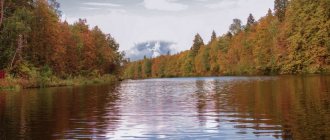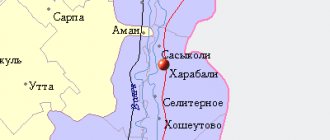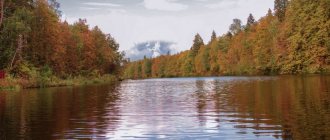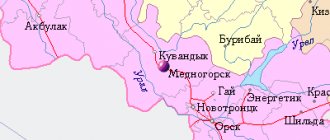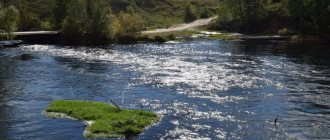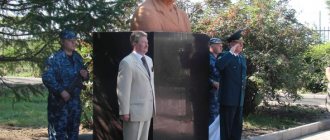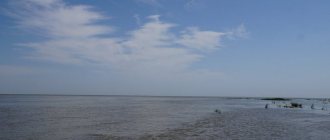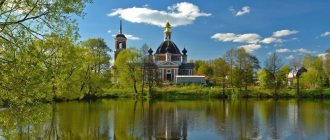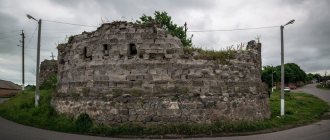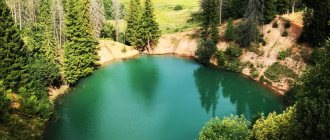The Oryol region is known mainly thanks to the writers and poets who lived here at different times. Museums have been opened in honor of some of them. The second tourist destination is religious. There are monasteries, churches, cathedrals, and holy springs here. But the area is also famous for other places that will be of interest to tourists. In addition, you should definitely see the sights of the Oryol region.
Oryol region: must-sees
Each region has places that best convey its atmosphere, tell about the past and predict the future.
Spasskoye-Lutovinovo Museum-Reserve
- Address: Museum street, 3, village of Spasskoye-Lutovinovo.
Family nest I.S. Turgenev - the Spasskoye-Lutovinovo estate - a monument to the historical and cultural heritage of the peoples of Russia. The estate was granted to the Lutovinov family for good service back in the 16th century by Ivan the Terrible. And then it was inherited by the writer’s mother.
Once it was a large estate with its own theater, church, almshouse, and hospital. Today, many of the buildings have not survived. This is to blame for the terrible fire of 1839, in which not only the buildings, but also part of the house burned down.
After the writer's death, the estate fell into disrepair and was then nationalized. Now it houses a museum dedicated to the work of I. S. Turgenev. The house has been completely recreated as it was during the writer’s lifetime, personal belongings, interior items and various collections belonging to the Turgenev family have been collected.
The park with ancient linden trees has also been preserved - an excellent example of 19th-century garden art. In one of its corners there is an old oak tree, several girths long, planted with his own hands, then still a young writer.
Saburovskaya fortress
- Address: Oryol district, Saburovo village.
The architectural monument in Saburov is all that remains of the Kamensky estate. This is a garden wall stylized as a fortress, the length of which is 1.5 km. In addition to it, the ensemble includes the Church of the Archangel Michael, the author of which is called the famous architect Rastrelli, 4 towers and a theater building.
Little remains behind the fortress walls. Particular attention is drawn, perhaps, to the powder magazines, which were used as glaciers. From the house itself, only parts of the foundation and fragments of the steps leading to the garden survived. Despite this, the Saburov Fortress is considered the best preserved among the estates of that time.
Adam's Mill in Livny
- Coordinates on the map: 52.395989, 37.654961.
The 6-story mill, owned by the Adamov merchants, was considered a real miracle of technology at the end of the 19th century. The day of its launch became a tragedy for the eminent family. When the hydraulic turbines failed to turn, Fyodor Adamov, who had invested not only money but also hopes in his brainchild, hanged himself right at the mill.
The son of the deceased made his father's dream come true. The mill operated until the start of the Second World War, and occupied one of the leading places in the country in terms of the quantity of flour products.
Today the building is already 150 years old, and it is going through hard times. Wind, humidity and vandals will eventually finish the job. Moreover, there is no talk of restoration of the building.
Local residents consider the mill one of the main attractions and recommend it to all visitors. True, it arouses interest only among incorrigible romantics and lovers of abandoned buildings.
Krivtsovsky memorial
- GPS coordinates: 53.481158, 36.279832.
The Valley of Death was the name of the floodplain of the Oka and Zushi during the Second World War. In 1970, a memorial was opened here in memory of the fallen Soviet soldiers. It consists of two parts. In front of the two mass graves stands a 9-meter obelisk and an eternal flame burns.
Nearby there is a monument to fallen soldiers. It is a 15-meter stele in the form of a pyramid on which a soldier leans.
Lipovchik Memorial
- Coordinates: 52.375858, 37.623719.
One of the most terrible places in the region is in the Livensky district, in the Lipovchik tract. Here in 1937-38. the repressed were shot and buried. This place was discovered by chance, by school students during a hike. Then, on the washed-out slope of the ravine, they found human bones.
For a long time it was believed that they belonged to those killed in the Second World War. The truth was revealed only after perestroika. At the same time, lists of those executed were compiled, among which were people of completely different classes and nationalities.
In 1992, a memorial to the victims of repression was opened at this site, and in the mid-2000s, the Russian Orthodox Church installed a worship cross next to it. Several times a year a liturgy is served in the tract, and sometimes a procession of the cross is held. On October 30, the Day of Remembrance for Victims of Political Repression, a memorial service is held here every year.
Souvenirs
Tourists who want to bring home nice gifts often choose eagle figurines.
Souvenir shops offer inexpensive items made of wood and metal alloys. Stone figurines are more expensive. Local craftsmen make them in different versions - eagles on bones, coins and branches. There are plenty to choose from!
In the Oryol region, an ancient folk craft has been preserved - the Oryol list.
This is the name for the original embroidery with geometric patterns, predominantly red. On sale you can find embroidered linen towels, napkins, aprons and tablecloths.
Oryol Museum of Fine Arts
Lovers of ceramics love the funny toys from Pleshkovo - ladies, horses, fairy-tale animals and whistles in the shape of birds.
The souvenir shops have a large selection of black-polished pottery, elegant vases and plates with memorable inscriptions.
Light and airy lace is brought from Mtsensk.
However, you need to keep in mind that handmade products require a lot of skill and time, so they are not cheap. Since the middle of the 19th century, beautiful sonorous accordions - livenki - have been made in the city of Livny.
Oryol Museum of Local Lore
What should lovers of delicious souvenirs bring? Tourists willingly buy Oryol beer, which is prepared using pure spring water from Oryol Polesie.
Popular among those with a sweet tooth are candies, marshmallows and marmalade made at a confectionery factory that operates in Orel.
| ← RUSSIA | EUROPE → |
The most beautiful rivers and lakes of the Oryol region
Artificial reservoirs can be no worse than natural ones. Proof of this is the Oryol region, where most of the lakes are man-made. And rivers are beautiful in themselves.
Arrow of Orlik and Oka
- Coordinates: 52.969015, 36.069260.
Where the Oka and its left tributary Orlik merge into a single whole, the main attraction of modern Orel is located. It was on this site that a military fortress called Orlovskaya was founded in the 16th century. In 1966, the city turned 400 years old. In honor of this, a memorial stele, 27 m high, was installed on the spit, on which his story is written.
Lake Central
- Coordinates: 53.271622, 35.260636.
Lake Central is the pearl of the Khotynetsky district and the Oryol Polesie park. Anyone who sees a reservoir for the first time will never guess that it is of artificial origin. About 20 years ago peat was mined here.
The remaining pits were gradually filled with rainwater until they turned into a charming lake. The water in it is very clean, despite the brown tint and unpleasant peat smell.
In the vicinity of the reservoir there are many living creatures: badgers, jerboas, ferrets, golden eagles, black grouse. The flora is also diverse. Thanks to this, Lake Central was declared a specially protected natural monument.
Tson River
- Coordinates: 52.956664, 35.607008.
The source of the Tson River is in the Bryansk region, but only the first few kilometers are there. The rest of the way the river travels through the territory of the Oryol region until it merges with the Oka. The length of the river is about 74 km. Its shores are very picturesque and have been inhabited by people since ancient times.
Lake Old
- Coordinates: 53.300029, 35.289714.
One of the artificial reservoirs in the Oryol Polesie park is very popular among fishermen. There is always a lot of different fish in it, because it, like all reservoirs in the park, is regularly stocked with fish. The most striking representatives of the ichthyofauna are crucian carp, pike, carp, and grass carp. You can also swim here, though only on one side. The one with the beach. The rest of the coast is lushly overgrown with forest.
Lake Bright Life
- Coordinates: 52.918206, 36.042925.
This is one of the few reservoirs in the Oryol region where recreation and swimming are officially permitted. This is a former sand quarry. In 1971, they decided to fill it with water from the Oka, stock it with fish, and since then it has been actively used for recreation by local residents. The reservoir is located in one of the districts of Orel.
There are places for rest here. A sandy beach and clean water, changing cabins, sun canopies - all this attracts vacationers here.
Often the shore of a reservoir becomes a venue for celebrations, discos and beach festivals. For fishermen there is plenty here - bream, crucian carp, perch, roach. And you can fish all year round without restrictions, in any permitted way.
Nugr River
- Coordinates: 53.358496, 35.859453.
A tributary of the Oka originates in the Khotynetsky district, near the village of Moshchenoe. The river is only 100 m long and 1-2 m deep. However, during floods the water level can rise up to five meters.
Nugr is most suitable for rafting tourism. Where the channel is wide, the current is slow and calm. But in narrower places the river begins to boil like a real mountain stream, rolling over a rocky bottom.
On the shore of Nugr stands the ancient city of Bolkhov, frozen in the past, the 19th century. Even from the river bank you can see the gilded domes of churches, merchant houses that have survived to this day, and an ancient monastery. After Bolkhov, Nugr begins its journey to the Oka River and merges with it near the border with the Tula region.
Eagle
The Oka River divides the city in two. Unlike Moscow and St. Petersburg, its shores are not bound by granite. They have picturesque cliffs, bushes and beaches.
Turgenev gazebo in Orel
Tourists who come to the regional center can see monuments of civil and temple architecture, visit museums and walk through green parks. Guests of Orel really like the picturesque landscaped park “Nobles’ Nest”, which is located on the steep left bank of the Orlik River. There is an elegant “Turgenev gazebo” and a monument to the writer installed here.
On the left bank of the Oka there is a large park of culture and recreation. The history of the green zone for city residents began in the 20s of the 19th century, when a public garden was laid out on the site of a wasteland. The park area was heavily damaged during the occupation of Orel from 1941 to 1943, but was later restored. Today it is a favorite walking place for city residents and tourists.
House-Museum of N. S. Leskov in Orel
The oldest stone building in Orel is located at 5 Voskresensky Lane. The two-story building was erected in 1795 for a four-year boys' gymnasium. Today, the history department of the city university is housed in a beautiful monument of classicism.
Mysterious caves of Oryol region
The underground world has always worried those who live on the surface. That is why caves are always studied especially carefully. Maybe they are where the secrets of all humanity are kept.
Pyatnitsky caves
- Coordinates: 52.951293, 36.089745.
Karst caves on the banks of the Oka already existed when, in the 18th century, Catherine II issued a decree to use them for the production of white stone. Mining stopped only in the 20th century.
During the Second World War, the caves served as a reliable shelter for partisans and local residents from the Nazis. There are 4 caves in total, each of them is about 500 m long. Today they are used to attract tourists.
Mtsensk caves
- Coordinates: 53.299168, 36.580832.
The caves on the banks of the Zushi near Mtsensk have been known for a very long time. Scientists continue to debate about them. Some believe that these are ancient quarries, others insist on natural origin. All caves were given the name Mtsenskaya and a serial number. There are 8 of them in total.
Speleologists explored each of them. The first 6 are similar to each other, consisting of a hall and several dead-end passages. Their depth is about 2 m.
The last cave consists of three halls with low passages between them. From one hall you can go to the surface. Mtsenskaya-7 is the most interesting cave of the group. It is famous for its 10-meter gallery ending in a flat wall.
Fishing
Anglers like Oka, where you can catch pike, perch and roach. In addition to the Oka, fishermen have chosen the banks of Zushi, Bystraya Sosna, Nerussa and Svapa.
In the Oryol region, paid fishing in reservoirs is popular. Fishing enthusiasts like Boytsovsky, Romanovsky, Selkin and Kalineevsky ponds.
Lake Shakhovo, where there is a small fish farm, is considered a catching place. The average price for fishing is 500 rubles per day. Fishermen are allowed to fish with two hooks, and the catch limit is 4 kg.
Holy Vvedensky Convent
Many tourists come to the reservoir near the village of Kokareva, 30 km from the regional center. Cupid, carp, crucian carp and pike are bred here.
Fishermen pay an environmental fee of 150 rubles and pay 150 rubles per 1 kg of caught carp and grass carp. The catch of crucian carp is allowed to be taken home free of charge.
National parks and reserves
Nature is everything that surrounds us. But there are special places that have no analogues. For this purpose, protected areas are created to preserve the wonderful landscapes of the Oryol region.
Oryol Polesie
- Coordinates: 53.255652, 35.294967.
The national park is located on the territory of Znamensky and Khotynetsky districts, covering an area of more than 75 thousand hectares. It was formed in 1994 on the initiative of Academician of the Russian Academy of Sciences E. S. Stroev.
Characters from Turgenev’s “Notes of a Hunter” lived here, Nightingale the Robber and his gang took refuge here, the ancient village of Lgov and the remains of the ancient Russian fortress Khotiml are located. Oryol Polesye is home to the largest population of bison and muskrat, and there are more than 170 species of rare plants.
Shatilovskaya experimental station
- Address: Novoderevenkovsky district, Shatilovo village, 79.
One of the main attractions of the Oryol region is located in the former Shatilov estate. For 125 years now, research has been carried out here, selection work has been carried out, new varieties have been developed, and fertilizers have been tested.
The modern station cooperates with many research institutes and experimental sites not only in Russia. Material for research is sent even from abroad.
And it all started with 65 hectares of land, which I.I. Shatilov dedicated his family estate to the introduction of advanced farming techniques.
Here, at different times, plant nutrition and the use of phosphorus fertilizers, the influence of various agricultural practices on crop yields were studied. Many famous scientists worked in Mokhovoy, such as breeder P.I. Lisitsyn.
Oryol Arboretum
- Coordinates: 53.003971, 36.070381.
The dendrological park belongs to the All-Russian Research Institute for Selection of Fruit Crops. It began to be created in 1968. All botanical gardens of the Soviet Union were involved in the creation of collections.
Today, about 300 rare plants from all over the world are collected here. There is a very rare cherry birch, with red-brown bark. And the relict Radde birch - the same age as dinosaurs - is listed in the Red Book.
Tourism opportunities
In the Oryol region there are enough places where you can stay for a day or two or spend a vacation. These are hotels, guest houses, recreation centers, tourist centers, sanatoriums, boarding houses and country clubs. The hotel business is especially developed in Orel and Mtsensk.
Source of the Oka River
An overnight stay in a hostel will cost 250-300 rubles. Apartments for two cost from 900 rubles per night. In the regional center, tourists are received by a five-star hotel, for which they ask for 3,800 rubles per day. Tourists who travel economically prefer to stay in the private sector. They rent apartments or country houses.
Bus excursions from Moscow and other Russian cities are carried to the Oryol region. If you come here on your own, you can use the services of local travel companies. From Orel, travelers are offered one-day excursions to an eco-farm in Oryol Polesie, to Spasskoye-Lutovinovo, the Church of the Intercession of the Blessed Virgin Mary with the crypt where the poet Afanasy Fet is buried in Kleymenovo and to the Zlynsky stud farm.
St. Sergius Cathedral in Livny
Oryol waterfalls and springs
Springs are phenomena that not only can, but must be admired. It is from them that people need to learn perseverance and the ability to reach their goals.
Source of the Oka
- Coordinates: 52.357282, 36.216463.
One of the largest rivers in Europe begins in the Glazunovsky district of the Oryol region, near the village of Aleksandrovka. This is a small spring flowing into a man-made stone pool.
The area around it is considered a park area, surrounded by walls, and has an entrance gate. The space next to the pool is decorated with wooden figurines of fairy-tale characters, and there is a chapel nearby.
Source of Saint Kuksha
- Coordinates: 53.342596, 36.428532.
John Kuksha is one of the most revered saints in the Oryol region, a preacher of Christianity who lived 900 years ago. The spring that bears his name is located in the forests of the Mtsensk region.
According to legend, it was at this place that Saint Kuksha was killed by the pagans. It has survived to this day only because it was located in a hard-to-reach place.
Today the area around it is landscaped. A wooden stage leads to the covered font, and there are benches for rest everywhere. Visitors note that everything here breathes purity and goodness.
Holy spring Kamenets
- Coordinates: 52.479833, 36.829423.
One of the most mysterious places in the Oryol region is located in the Pokrovsky district. The source itself has been known since the 16th century, but only recently have they begun to refine its territory and study its phenomenal properties.
The spring is a deep ravine, the bottom of which is lined with stone slabs with an uneven surface. The entire area around it is strewn with the same stones.
These amazing stones are considered alive and are credited with healing properties, like spring water. They look really unusual. It was as if they had been heated, causing the surface to boil and bubble, and then suddenly cooled.
A metal staircase leads to the source and there is a swimming pool. There are bridges across the stream, and the faces of saints are located on the stones.
Lukovetsky waterfalls
- Address: Lukovets village, Maloarkhangelsk district.
The hydrological natural monument is located in the Maloarkhangelsk region, near the village. Onion. These are groundwaters that come to the surface from Devonian limestones, forming 4 powerful springs.
The first source is at the base of the ravine, the rest are downstream of the river. Pine. Falling from a meter height, they form waterfalls. The water in them has no taste or smell, is clean and transparent.
Where the water from the third spring falls, a spring comes out of the ground. The water in it is completely different from that in the springs. Although it is transparent, it has a yellowish tint and an iron taste.
Holy Spring of John the Baptist
- Coordinates: 53.282433, 36.563983.
A spring under the Cathedral Mountain in Mtsensk appeared, according to legend, in 1415. Then almost the entire population of the city gathered on the right bank of the Zushi. The occasion was a huge stone floating along the river with an image of St. Nicholas the Wonderworker and a cross carved on it.
Before the eyes of the amazed residents, the stone stuck to the mountain, and in that very place a spring began to flow. Having witnessed such a miracle, the townspeople were baptized, and a church was installed on the top of the mountain. The source still exists today. A roof was installed over it, a bathhouse was built, and the area around it was landscaped.
Transfiguration Cathedral
The beautiful 6-altar Church of the Transfiguration of the Savior was built in 1841-1851. at the highest point of Red Mountain - this is the main shrine of the city of Bolkhov, Oryol region. The cathedral is a striking example of the Russian style, the founder of which was the architect K. A. Ton and resembles the architecture of temples common in the 16th century.
The majestic temple dominates the entire city and is visible long before approaching it. The previously existing wooden Spaso-Preobrazhensky Cathedral was completely restored in stone: new beautiful domes and golden crosses were installed, the exterior decoration was restored, including ancient decor, and the tower clock, donated to the city by a local doctor, was repaired.
Currently, the relics of confessor George Kosov, a resident and native of Bolkhov, rest in the Transfiguration Cathedral. Excavations continued for several days until the relics of the saint with a cross in his right hand were found. In the summer of 2000, at the Council of Bishops, the confessor was canonized.
Historical sights of the region
History is our past. How many mysteries we inherited. In the Oryol region these are ancient settlements, strange stones, and mounds that carefully guard their secrets.
Mount Samorod
- Coordinates: 53.281605, 36.561657.
A high hill with steep slopes on the left bank of the Zushi is called Cathedral or Mount Samorod. Once upon a time there stood the ancient Mtsensk fortress.
In the 16th century, two monasteries were founded - the Peter and Paul Tabernacle and the Ascension, and 100 years later - several fortresses that communicated with the outside world through manholes and passages.
At the top of the mountain stood a beautiful stone temple - St. Nicholas Cathedral. It was destroyed in the 30s. XX century. Today, the top of Mount Samorod is crowned by the St. Nicholas Chapel, built in 2000.
Stone megaliths in Dumchino
- Address: s. Dumchino, Mtsensk district.
The boulders in the Dumchinsky forest are nothing more than a megalithic complex. These are the so-called trace stones of glacial origin. On their surface you can see the imprints of human footprints, paws of animals and birds.
Local residents considered them divine. Some of the boulders here have very strange shapes and look more like people or animals.
There is a strange energy in this place. The compass needle often dances, you lose your bearings, and your head starts to hurt. The forest itself is called “rotten” not only because of the dampness, but also because of the many diseased trees.
Kurgan burial ground Radovishte
- Coordinates: 53.270232, 35.370583.
The archeological monument is located on the territory of the Oryol Polesie National Park, next to the ancient Baltic settlement of the same name. It is believed that this was the first settlement established by the northern tribes on their way to the south.
The burial ground, located 1.5 km from the settlement, no longer belongs to the Balts, but to the Vyatichi Slavs. It is considered one of the largest and most preserved in the Oryol region.
For several centuries, clay vessels containing remains from cremations were buried here. During excavations in the mounds, neck torcs, beads, knives, and temple rings were found.
Khotyml ancient settlement
- Address: Khotynetsky district, Khotiml-Kuzmenkovo village.
The settlement, which was once one of the largest fortresses in the Oryol region, is located in the village of Khotiml-Kuzmenkovo. It is located on one of the banks of the right tributary of the Vytebet, and rises 5 m above it. It is a fortified settlement, surrounded by a ring rampart and a two-meter-deep ditch.
Inside the fortress walls there was a Kremlin, boyar mansions, and warehouses. There was also a spring, with the help of which the inhabitants of the fortress could withstand a long siege. Excavations have shown that Khotiml ceased to exist around 1310.
Blue stone in the Olkhovets tract
- Address: Olkhovets tract.
This stone is the only one of its kind in the Oryol region. According to legend, the mark on it belongs to the Lord himself. Standing on a stone, he prayed for the victory of Christians over the troops of Devlet-Girey during the Battle of Judgment.
This boulder is truly huge. Its weight is about 45 tons, and the depth of the track is almost 10 cm. By all parameters, this is the largest track in Central Russia. And it is called blue because of its peculiarity. After rain, the gray surface of the stone, formed by quartz biotites, changes color, refracting and reflecting the sun's rays.
Temples and monasteries
Many tourists come to Vyatsky Posad.
The modern Orthodox center combines a gymnasium, a spiritual boarding school and an artel of craftsmen. On its territory there are two temples and an expressive over-chapel. Vyatsky Posad appeared not so long ago - in 2012, but quickly turned into a popular pilgrimage center.
The most sacred places on Oryol land are ancient Christian monasteries. There are active male monasteries in Mtsensk and Orel, and female monasteries in Orel and Bolkhov. One of the oldest churches - St. Sergius Cathedral is located in the city of Livny.
The first documentary evidence about it appeared at the end of the 16th century. The surviving stone building was built in the 60s of the 17th century.
Spiritual Orthodox
Abandoned estates: heritage of the Oryol region
The 20th century destroyed the heritage of the past. The beautiful architecture of noble estates and castles will no longer enchant the hearts of romantics. Over time, everything will sink into oblivion, down to the last brick. All that will remain of its former splendor are beautiful pictures in history books.
Hunters Castle
- Address: 1, Yakovka village.
A luxurious castle in the Gothic style is located in the village of Yakovka, Kolpnyansky district. It was built on lands granted by Catherine II to court councilor Ya.A. Okhotnikov. Later it passed to his descendant, who built this building. But he did not settle there himself, but opened a sugar factory.
After the revolution, the beautiful castle was nationalized. It housed first a village club, then a canteen. Today, nothing of the interior decoration remains. Only the walls have survived - excellent examples of 19th-century architecture.
The Golitsyn estate in the village of Golun
- Address: s. Golun, Novosilsky district.
The history of the estate began in 1780, when Prince M.A. Golitsyn acquired the village of Golun. Today this is the territory of the Novosilsky district. There was a horse yard and a cloth factory there. A little later, a magnificent architectural ensemble appeared, built according to the design of A.N. Voronikhin in classical style. It consisted of a manor house with outbuildings and a church.
The Great Patriotic War and time did not spare the estate. All that remains of it is the horse yard and some of the outbuildings have been preserved. Now they are used as outbuildings by local residents.
Shvartsev Estate
- Address: 3, Belyi Kolodez 1st village.
The family estate of the world-famous artist V. G. Schwartz is located in the village of Bely Kolodez, Kolpnyansky district. This is one of the main attractions of the Oryol region. Today, very little remains of the estate.
The station building, which is often confused with the manor house, is the best preserved. The building is already more than 200 years old, but it is gradually being destroyed. Of the outbuildings, the walls of the barnyard and stables are still standing.
The church-mausoleum in which the famous artist was buried was destroyed in 1965. It remains in this condition now. The abandoned estate can rightfully be called the ruins of a beautiful noble life.
Kurakins' estate
- Address: s. Preobrazhenskoye, Sverdlovsk district.
The Preobrazhenskoye estate, owned by Prince A. B. Kurakin, amazed everyone with its splendor, rivaling the palaces of emperors. A linden alley led to the estate gates; at the entrance there were guardhouses with installed obelisks. The three-story palace was built of wood, as were the church and numerous outbuildings.
Even for the servants, separate houses were built according to a single design. Adjacent to the manor house was an amazingly beautiful park with fruit trees, flower beds and flower beds, pavilions and greenhouses. More than 800 people were required to serve the “noble nest”.
Everything fell into disrepair with the death of the owner. His descendants were unable to appreciate the splendor of the past era. During the Second World War, there was an ammunition depot on the estate's territory, which was blown up during the Nazi offensive. This is how “The most famous noble nest of the Oryol region” was destroyed
Sheremetev estate in Glazunovo
- Coordinates: Mtsensk district, Glazunovo village.
V.A. Sheremetev, an actual privy councilor from an untitled branch of the family, acquired the estate in the 60s of the 19th century for his youngest son. He didn’t visit Glazunovo often, preferring the romance of Paris, but he still brought order.
A stone palace appeared on the estate, equipped with an artesian water supply, a luxurious library, baths and an oil generator that generated electricity.
Behind the estate there was a park with cascading ponds and a church resembling a park pavilion. It has survived to this day, although it is not used for its intended purpose. In addition to the church, a water pump, a barn, a stable building and an upper pond survived.
Be sure to look at interesting places in the cities of the Oryol region - Mtsensk and Orel
Holy Trinity Church
The church is located in the town of Bolkhov, Oryol region, on the territory of the former Kremlin. This is one of the oldest and most beautiful architectural monuments in the region. The current 5-domed church was built from red brick on the site of a wooden one in 1708. The beautiful patterns of the temple, its expressive silhouette make the church a pearl of Russian architecture: bright flies with colored tiles, openwork archivolts, cornices with kokoshniks made of shells, a wonderful combination of white stone and red brick, bell tower with rich decoration. The decoration of the church is made in the style of Moscow churches of the 18th century.
In this sacred and beautiful place the revealed icon of the Mother of God (Kazan) is kept. Once upon a time, under the mountain of the church, at the site of the apparition, the merchant Kachanov built a small stone chapel, but, unfortunately, it has not survived to this day. Work is currently underway to restore the Trinity Church; the bell towers were restored in 2005.
Places for active recreation
The Oryol region is not only about religious shrines and abandoned estates. Athletes are also welcome here and are always welcome. All conditions have been created for active recreation in the region.
Gorki 57
- Coordinates: 53.087247, 36.061860.
The active recreation park, located near Orel, is the only all-season resort in the region. You can ski and snowboard here both in winter and summer thanks to artificial snowmaking. Visitors are offered a choice of 6 trails of varying difficulty with height differences of up to 60 m.
Those who don't like skiing can go tubing. There are 2 descents equipped for them. The park has lighting, so you can ride until late in the evening, and fresh air and a beautiful panorama are a pleasant bonus to your relaxation.
Pronino
- Coordinates: 53.141464, 36.207343.
The Pronino tourist center, located near Orel, will appeal to winter sports enthusiasts. All types of skis, snowboards, sleds, steep slopes and turns. And, of course, a powerful adrenaline rush. The slopes here are prepared not only for experienced skiers.
Beginners who want to try their hand are offered a specially equipped, lightweight track and the accompaniment of an instructor. In addition, Pronino is not only a tourist base. Regional alpine skiing competitions are held here every year.
Zlynsky stud farm
- Coordinates: 53.275266, 35.963898.
The life's work of V.N. Telegin, a great lover of horses, is a stud farm in the village of Zlyn. It was founded in 1872. First in the Kolpnyansky district, but later it was moved to Orlovsky, where it is located to this day.
At first, Telegin bred only Oryol trotters. Then, crossing them with an American standardbred horse, he developed a new breed - the Russian Trotter. Money from the sale of horses and victories in competitions went to the maintenance of the winners themselves and the development of a stud farm.
After the revolution, it was practically destroyed by hungry peasants; only a couple of valuable horses were saved.
In the 20s of the last century, the stud farm opened again, but during the Second World War it was destroyed and plundered by the Nazis. And only five years after the victory, good times came for him. The stud farm was able to survive and maintain its livestock even in the difficult 90s.
Skete of Saint Kuksha
A very holy and extraordinary place: a monastery, a well-equipped path winding through the forest and leading to a suffering well, beautiful nature, silence and birdsong. This holy place is one of the ancient and revered healing springs of the Oryol region and all of Russia.
According to legend, Kuksha, together with his student Nikon, preached the Christian faith to the peoples living in the Oryol region, for which he was brutally killed. Now the relics of Kuksha are kept in the Kiev-Pechersk Lavra, and at the site of his death they began to build a monastery. Also here, at the supposed site of death, there is the “Suffering Well” and a holy spring, at which pilgrims gather every year on September 9 and hold a solemn prayer service.
Leskov House-Museum
The attractions of the Oryol region, in addition to the Turgenev estate, include the house of another famous writer - Nikolai Leskov. It is located directly in Orel itself in a small mansion of the late 19th century, which is surrounded by picturesque nature. It is dedicated to the work of the writer himself, where, in addition to his works, a large number of personal belongings are stored, which were transferred for safekeeping by his wife. The museum itself seems to be imbued with the heavy personality of the writer, showing his ordinary life. This museum is the only place in Russia that is dedicated to Nikolai Leskov, so most of his personal belongings are kept here.
Military History Museum
One of the branches of the Museum of Local Lore, military history, can also be considered a completely independent attraction of the Oryol region. There, on an ongoing basis, tourists are shown an exhibition that demonstrates bladed weapons and firearms used in Russia. In addition to the internal exhibition, there is also an external one, which contains various examples of military equipment.
The most important exhibition of this museum is its first and is a diorama showing the Oryol offensive operation. It is better known among the people as the Battle of Kursk, during which Russian troops managed to inflict a significant blow on the Nazis. In addition to artifacts from the war of 1941-1945, there are also items from earlier eras, such as the Middle Ages.
3. Park Hotel “Dream”
The name of the location speaks for itself. Just a 15-minute drive from the city is an incredibly beautiful complex on the Mezenka River. Beautiful scenery, clean air, natural expanse - this is an excellent location for a family holiday, where you can relax from the bustle of the city on the river bank. For those who love active entertainment, you can rent an ATV, and for children there is a rope park. “You can take with you a book by one of the great writers, natives of the Oryol province, to read in an atmosphere of peace,” the blogger advises. The Park Hotel is an excellent solution to spend a weekend in nature, while preserving all the benefits of civilization.
